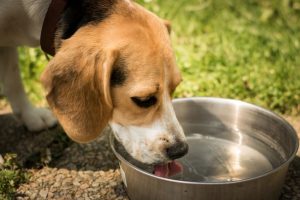We’ve had excellent results with our diets for kidney disease and want to share why and how that happens for most dogs – not all. This is almost always a case of ‘timing is everything’
Kidneys act as a filtering system by getting rid of toxic waste products. They balance the body’s fluid content by reabsorbing immense amounts of water into the blood, produce hormones that help to make red blood cells and help to control blood pressure.
The food that your dog eats is broken down and part of this breakdown, along with the normal breakdown of body tissues becomes waste that’s sent to the kidneys for removal. When kidney function is compromised, the wastes build up can cause nausea.
The filtering units of the kidneys are called nephrons. Kidney disease causes nephrons to lose function, and since kidney damage is progressive and irreversible, nephrons are destroyed if left untreated.
By the time typical blood test results specific to kidney disease alert us to the problem, about fifty percent of kidney function has been lost. A more specialized test called SDMA can alert us sooner.
Remarkably, a dog may not show obvious signs of a problem even at this stage and symptoms may not be specific to kidney disease alone. While not all signs will be seen in every dog, here are some to look for:
- Increased water consumption
- Excessive urination (volume and/or frequency)
- Lessened appetite
- Weight loss
- Depression
- Vomiting
- Diarrhea
- Blood in urine
The success of any properly formulated diet is based on the dog eating it. Since most dogs experience some nausea as the disease progresses it’s critical to start them on a home-prepared diet right away. By doing this, you’re able to spare the kidneys from having to try and cope with the burden of diets that aren’t specific to your dog’s changed nutrient requirements. To catch the disease in time means seeing your vet for blood tests every year for healthy dogs and every six months for older (7 and up) dogs.
What happens when we have a client who reaches us in the very early stage of the disease is that we’re able to use foods the dog enjoys and provide some variety if different foods are tolerated. The dog has the time (from a health perspective) to show us if a higher fat diet is tolerated. Dietary fat is more tempting to some dogs and provides calories without adding phosphorus (the mineral we want to limit for these cases).
Now and then we get a case of a dog having been fed for many months, sometimes a year or more of an improper diet and although we can often help, the outcome can’t be as good since we have no way of reversing nephron damage.
The take-home message is Don’t Wait! Have your dog tested and feed a properly balanced diet to extend quality of life and even longevity itself.


